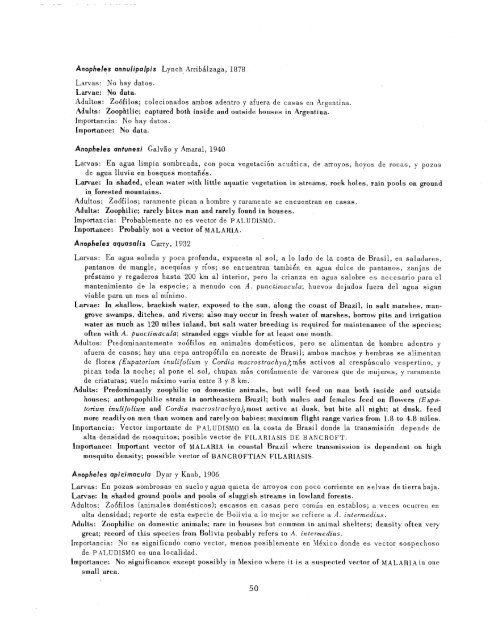clave ilustrada para los mosquitos anofelinos de sudamerica oriental
clave ilustrada para los mosquitos anofelinos de sudamerica oriental
clave ilustrada para los mosquitos anofelinos de sudamerica oriental
Create successful ePaper yourself
Turn your PDF publications into a flip-book with our unique Google optimized e-Paper software.
Anopheles annuiipalpis Lynch Arrib&lzaga, 1878<br />
Larvas : No hay datos.<br />
Larvae: No data.<br />
Adultos: Z oo ‘f-1 1 OS; colecionados ambos a<strong>de</strong>ntro y afuera <strong>de</strong> casas en Argentina.<br />
‘4dults: Zoophilic; captured both insi<strong>de</strong> and outsi<strong>de</strong> houses in Argentina.<br />
Importancia: No hay datos.<br />
Importance: No data.<br />
Anopheles antunesi GalvZo y Amaral, 1940<br />
Larvas : En agua limpia sombreada, con poca vegetacibn acugtica, <strong>de</strong> arroyos, hoyos <strong>de</strong> rotas, y pozas<br />
<strong>de</strong> agua lluvia en bosques montai?&.<br />
Larvae: In sha<strong>de</strong>d , c 1 can water with little aquatic vegetation in streams, rock holes, rain pools on ground<br />
in forested mountains.<br />
Adultos: Z oo ‘f’l 1 OS; raramente pican a hombre y raramente se encuentran en casas.<br />
Adults: Zoophilic; rarely bites man and rarely found in houses.<br />
Importancia: Probablemente no es vector <strong>de</strong> PALUDISRIO.<br />
Importance: P 10 b a bl y not a vector of MALARIA.<br />
Anopheles aquasalis Curry, 1932<br />
Larvas : En agua salada y poca profunda, expuesta al sol, a lo lado <strong>de</strong> la costa <strong>de</strong> Brasil, en saladares,<br />
pantanos <strong>de</strong> mangle, acequlas y rl’os* ,-se encuentran tambi& en agua dulce <strong>de</strong> pantanos, zanjas <strong>de</strong><br />
prkstamo y rega<strong>de</strong>ros hasta 200 km al interior, pero la crianza en agua salobre es necesario <strong>para</strong> el<br />
mantenimiento <strong>de</strong> la especie; a menudo con A. punctimacula; huevos <strong>de</strong>jados fuera <strong>de</strong>1 agua sigan<br />
viable <strong>para</strong> un mes al mlnimo.<br />
Larvae: In s h a 11 ow, brackish water, exposed to the sun, along the coast of Brazil, in salt marshes, man-<br />
grove swamps, ditches, and rivers: also may occur in fresh water of marshes, borrow pits and irrigation<br />
water as much as 120 miles inland, but salt water breeding is required for maintenance of the species;<br />
often with A. punctimacula; stran<strong>de</strong>d eggs viable for at least one month.<br />
Adultos: P re d ominantemente zo6fi<strong>los</strong> en animales dome’sticos, pero se alimentan <strong>de</strong> hombre a<strong>de</strong>ntro y<br />
afuera <strong>de</strong> casas; hay una cepa antropdfila en noreste <strong>de</strong> Brasil; ambos machos y hembras se alimentan<br />
<strong>de</strong> flares (Eupatorium inulifolium y Cordia macrostrachya);m& activos al crespi&culo vespertino, y<br />
pican toda la noche; al pone el sol, chupan m&s comGnmente <strong>de</strong> varones que <strong>de</strong> mujeres, y raramente<br />
<strong>de</strong> criaturas; vuelo m&ximo varia entre 3 y 8 km.<br />
Adults: P re d ominantly zoophilic on domestic animals, but will feed on man both insi<strong>de</strong> and outsi<strong>de</strong><br />
houses; anthropophilic strain in northeastern Brazil; both males and females feed on flowers (Eupa-<br />
totium inuZifoEium and Coda macrostrachya);most active at dusk, but bite all night: at dusk, feed<br />
more readilyon men than women and rarelyon babies; maximum flight range varies from 1.8 to 4.8 miles.<br />
Importancia: Vector importante <strong>de</strong> PALUDISMO en la costa <strong>de</strong> Brasil don<strong>de</strong> la transmisidn <strong>de</strong>pen<strong>de</strong> <strong>de</strong><br />
alta <strong>de</strong>nsidad <strong>de</strong> <strong>mosquitos</strong>; posible vector <strong>de</strong> FILARIASIS DE BANCROFT.<br />
Importance: Important vector of MALARIA in coastal Brazil where transmission is <strong>de</strong>pen<strong>de</strong>nt on high<br />
mosquito <strong>de</strong>nsity; possible vector of BANCROFTIAN FILARIASIS.<br />
Anopheles opicimacula Dyar y Knab, 1906<br />
Larvas: En pozas sombrosas en suelo y agua quieta <strong>de</strong> arroyos con poco corriente en selvas <strong>de</strong> tierra baja.<br />
Larvae: In sha<strong>de</strong>d ground pools and pools of sluggish streams in lowland forests.<br />
Adultos: Zo&<strong>los</strong> (animales domdsticos); escasos en casas pero corn& en estab<strong>los</strong>; a veces ocurren en<br />
alta <strong>de</strong>nsidad; reporte <strong>de</strong> esta especie <strong>de</strong> Bolivia a lo mejor se refiere a A. intermedius.<br />
Adults: Z oop h-1’ J tc on domestic animals; rare in houses but common in animal shelters; <strong>de</strong>nsity often very<br />
great; record of this species from Bolivia probably refers to A. intermedius.<br />
Importancia: 3 o es significado coma vector, menos posiblemente en \lgxico don<strong>de</strong> es vector sospechoso<br />
<strong>de</strong> PALUDISMO en una localidad.<br />
Importance: N o significance except possibly in Mexico where it is a suspected vector of MALARIA~~ one<br />
small area.<br />
50
















